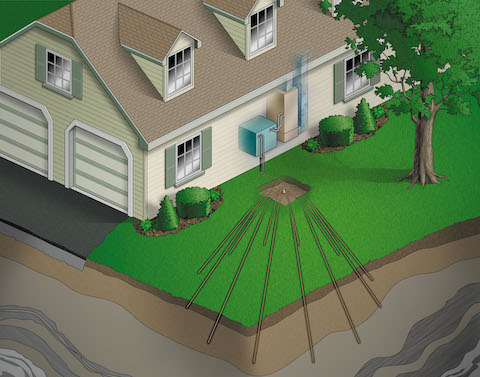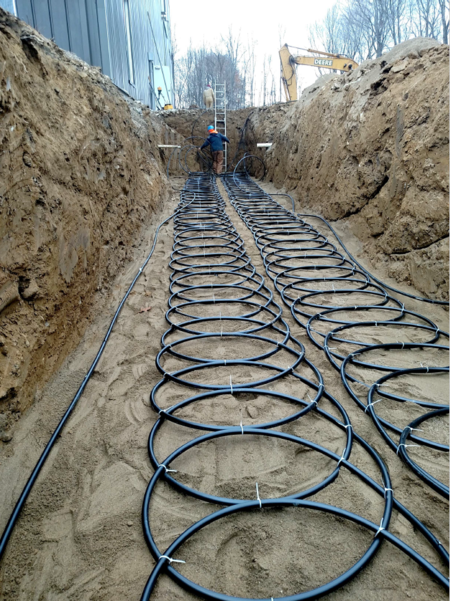
In previous episodes, we’ve talked about geothermal energy—the heat of the earth.
Where extreme heat is near the surface, it can be used to produce steam to drive electric generators. Where this heat warms groundwater, it makes hot springs.
But there’s another type of geothermal energy that’s more widely available: not extreme heat, but constant, low-temperature heat.
Anywhere in temperate latitudes, if you dig 10 feet or more below the surface, the ground is a near-constant mild temperature all year long.
You may have experienced this in a cave. Caves are warmer than the surface in winter and cooler in summer.
Low-temperature geothermal energy can work the same way in buildings, in place of conventional heat and air conditioning.
The core of the system is a network of pipes laid in shallow horizontal trenches or somewhat deeper vertical wells.
Through these, a fluid circulates, taking on the temperature of the earth—between 45 and 75 degrees Fahrenheit in the continental U.S., depending on latitude.
That liquid then passes through a heat exchanger in the building. Air blows over the tubing, takes on the temperature of the fluid, then blows through the house, office, or school.
These systems, supplemented as needed, can keep buildings a mild, constant temperature year-round.
The network of pipes is more expensive to install than conventional systems, but the energy savings can pay off the difference in several years.
Maybe that’s why 50,000 of these systems are installed in the U.S. each year.
Background
Synopsis: In past episodes of EarthDate, we have talked about direct geothermal energy from hot springs and extreme geothermal energy from near magma chambers, both of which require natural heat sources that only occur in certain locations. But there is another type of geothermal energy that is accessible pretty much everywhere: geothermal-exchange heat pumps.
- “Geothermal” comes from two Greek words: geo, or “earth,” and therme, meaning “heat.”
- Almost anywhere you go in the United States (except some parts of Alaska), if you dig down about 10 ft (3 m) below the surface, you will find that the ground maintains a fairly constant temperature that ranges from 45° to 75°F (7° to 21°C).
- This locally constant temperature can be used to help heat buildings in the winter and cool buildings in the summer.
- Caves provide a good example: in the winter, the ground temperature is usually warmer than the air temperature, and in the summer, it is usually cooler.
- Geothermal-exchange heat pump systems have been around since the 1940’s and may also be called GeoExchange, earth-coupled, ground-source, or water-source heat pumps.
- Heat pumps don’t have to rely on geothermal energy, however. In fact, standard heat pumps rely on outside air to heat a home in winter and cool it in summer.
- They don’t generate heat, they move heat. In the summer, they pump heat from inside the house to outside the house, and in the winter, they reverse the process.
- Heat pumps consist of indoor and outdoor air-handler units, connected by pipes that circulate refrigerant. They then circulate the warmed or cooled air through a house or building.
- Moving heat is easier than creating heat, so these systems cost less to operate than furnaces or air conditioners. However, they do cost more to install.
- Heat pumps work well in moderate climates where heating and air conditioning needs are not extensive. In particularly cold climates, a furnace might be needed as a supplement.
- Geothermal-exchange heat pump systems are even more efficient than standard heat pump systems because they receive a boost from exchanging heat with the ground, which stays at a relatively constant temperature, instead of the outside air, which obviously fluctuates. So geothermal heat pumps use even less energy to heat and cool a building than a standard heat pump.
- They are also quieter and last longer, with less maintenance required.
- Geothermal-exchange heat pump systems use heat pumps (the inside and outside units connected by pipes) in combination with heat exchangers, which are systems of pipes (called loops) buried near the buildings they are heating or cooling.
- A fluid circulates continuously through the loop, staying at thermal equilibrium with the ground. This fluid may be water or water with antifreeze, a refrigerant.
- In the winter, the loop exchanges warmth with the air entering the heat pump, while in the summer, the loop cools the air before it enters the heat pump.
- The geothermal heat pump delivers air to the building the same way a regular heat pump does.
- Heat removed from the summer air can be used to heat water for household use.
- Ground-loop heat-exchange systems come in five basic types. Four are closed-loop systems usually made of plastic tubing that circulates an antifreeze solution. The fifth is an open-loop system that relies on groundwater. All of these systems can be used for residential or commercial installations, though local geology, hydrology, land availability, and cost will likely dictate the system type.
- One type, horizontal installations, requires large trenches that are 4–6 ft (1–2 m) deep and may contain multiple pipes or coils of pipe laid in the trench like a flattened Slinky toy for efficient ground-heat exchange.
- Vertical systems, another type, may be used if land area is limited or soil is too shallow to trench. Multiple 4-inch (10-cm)-diameter holes are drilled around 20 ft (6 m) apart to depths of 100–400 ft (30–120 m), then U-shaped pipes are inserted into the holes and connected at the surface.
- A third type of closed-loop system relies on ponds or lakes to moderate the temperature instead of the ground. These installations may cost less than the other types of closed-loop systems if there is a large enough body of water close to the building. Coils must be placed at least 8 ft (2.4 m) below the surface to avoid freezing.
- The last type of closed-loop system is a direct-exchange closed-loop system that pumps refrigerant through copper tubing buried in the ground. These systems can’t be installed in corrosive soils, however, and because they circulate refrigerant through the ground, local environmental regulations may restrict their use.
- Open-loop systems use well or surface water that circulates directly through the heat pump system before returning to the ground through recharge wells or surface percolation. This method requires abundant clean groundwater.
- In general, geothermal heat pump systems save energy and reduce noise and pollution, though they do cost more to install.
- Most geothermal systems pay back the extra costs of their installation in energy savings over 5 to 10 years.
- More than 50,000 geothermal exchange heat pump systems are installed in the United States each year.


